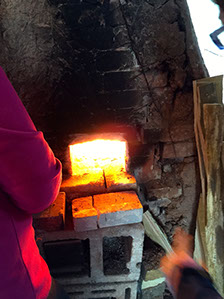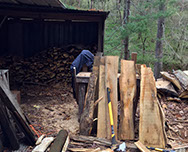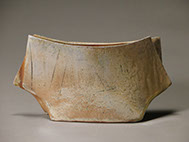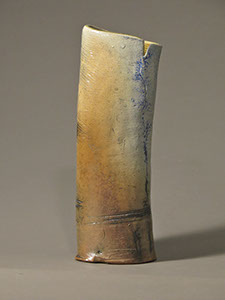Under the Scope





RONI POLISAR’ S SALT FIRING IN WOOD
Roni fires most of her work in a wood kiln. Unlike most types of kiln firings, wood firings are very labor intensive and require a good team of kiln participants. Wood kilns are fueled by large quantities of wood generally delivered in bulk in large pieces. The wood must first be chopped, split, and then hauled near the kiln to be steadily added to the kiln through the kiln’s firebox until the kiln temperature reaches about 2400 F. This takes about 24-30 hrs depending on the particular kiln and may take up to 3 wks for really large kilns. All sorts of wood are used: pine, oak, cherry are just a few.
Kiln participants work in 4-6 hour shifts — depending on the kiln firing coordinator. Volunteers for the wee hours of the morning are sometimes hard to find! It is the wee hours that Roni likes best as this is when salts are added to the firing. Roni fires in a
3-chambered wood kiln and one of the chambers is designated for salt. A variety of salt and sodium mixes may be used. Roni uses a mix of sodium carbonate and calcium carbonate combined with water. This forms a slurry that is poured onto boards that are thrown into the kiln through the firebox. The salts must be added at peak temperature reached towards the end of the firing so that they instantly vaporize allowing the free sodium to be carried through the chamber. The addition of salt creates a sodium silicate coating resulting in a glossy glass-like finish on the surfaces it touches. The sodium vapors also effect changes in glazes. Sometimes the soda-fired glazes look entirely different than the same glaze fired in the wood chamber. Salt firings in wood kilns bring the added beauty of the gloss to the ash created by the wood.
Roni observes that there is a natural asymmetry of surfaces on her wood-fired vessels. The side of the pot that faces the fire is more exposed to ash and salt than the opposite side creating differences in the pot’s surface and revealing how the flame carried the ash and salt around the pots. “Each piece is always unique and there is always an element of surprise,” says Roni. “If you like the effects of ash and salt, there is no other way to fire! That is what makes it all worth while!” Roni is not alone. The multi-chambered kilns Roni fires in are called noborigama kilns and were developed in Japan in the 17th c.
The unique, subtle effects and variations created by the salt and ash match Roni’s interest in achieving forms with structural strength while still expressing gesture and movement as well as showing process. She makes wheel-thrown vessels as she likes the volume wheel work allows as well as slab-formed vessels which allow her to create different forms and texture.
Roni does most of her work at her Burtonsville, Md home. Her studio — a converted horse stall — houses her kiln and wheel. She does most of her wood firings at Monocacy River Pottery in Md.
As a teenager, Roni was interested in ceramics and began her first studies at the Chrysler Museum Art School in Norfolk , Va. She continued her studies in ceramics at the University of Maryland where she earned a BA in Art History and an MA in American Studies focusing on culture, and moved on to become an Art Conservation Specialist at the Smithsonian. Roni continues to broaden her ceramic skills taking numerous workshops. Some of her favorite potters are Randy Johnson, Chris Staley, and Karen Karnes.
Roni was juried into Scope in 2015. She also participates in numerous exhibits at the Strathmore Museum, at the Academy of Fine Arts in Lynchburg, Va and at the Clay Coop in Rockville Md. In 2013 she won the Creative Craft Council Montgomery
Potters Award. You can see more of Roni's work at ronipolisar.weebly.com
Scope Gallery
Torpedo Factory Art Center
105 N. Union St.
Ground Floor, Studio 19
Alexandria, Va 22314
Phone: 703-548-6288
Winter 2022 Hours:
11:00 a.m. - 5:30 p.m. Thursday - Sunday
Check the Torpedo Factory website for any changes to the building open hours. www.torpedofactory.org/todays-hours/

